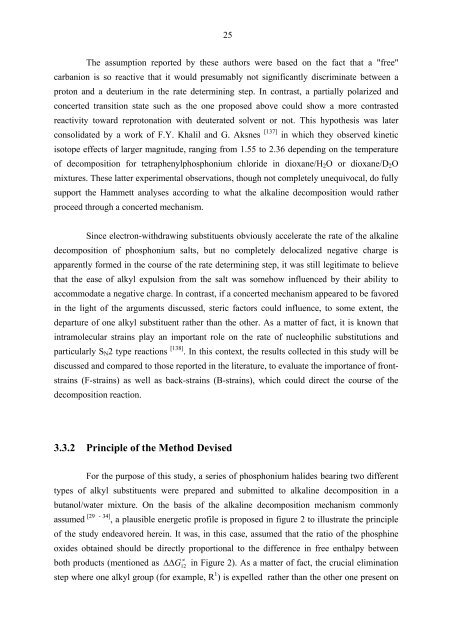My PhD dissertation - Institut Fresnel
My PhD dissertation - Institut Fresnel
My PhD dissertation - Institut Fresnel
Create successful ePaper yourself
Turn your PDF publications into a flip-book with our unique Google optimized e-Paper software.
25<br />
The assumption reported by these authors were based on the fact that a "free"<br />
carbanion is so reactive that it would presumably not significantly discriminate between a<br />
proton and a deuterium in the rate determining step. In contrast, a partially polarized and<br />
concerted transition state such as the one proposed above could show a more contrasted<br />
reactivity toward reprotonation with deuterated solvent or not. This hypothesis was later<br />
consolidated by a work of F.Y. Khalil and G. Aksnes<br />
[ ] 137 in which they observed kinetic<br />
isotope effects of larger magnitude, ranging from 1.55 to 2.36 depending on the temperature<br />
of decomposition for tetraphenylphosphonium chloride in dioxane/H2O or dioxane/D2O<br />
mixtures. These latter experimental observations, though not completely unequivocal, do fully<br />
support the Hammett analyses according to what the alkaline decomposition would rather<br />
proceed through a concerted mechanism.<br />
Since electron-withdrawing substituents obviously accelerate the rate of the alkaline<br />
decomposition of phosphonium salts, but no completely delocalized negative charge is<br />
apparently formed in the course of the rate determining step, it was still legitimate to believe<br />
that the ease of alkyl expulsion from the salt was somehow influenced by their ability to<br />
accommodate a negative charge. In contrast, if a concerted mechanism appeared to be favored<br />
in the light of the arguments discussed, steric factors could influence, to some extent, the<br />
departure of one alkyl substituent rather than the other. As a matter of fact, it is known that<br />
intramolecular strains play an important role on the rate of nucleophilic substitutions and<br />
particularly SN2 type reactions<br />
[ ] 138 . In this context, the results collected in this study will be<br />
discussed and compared to those reported in the literature, to evaluate the importance of front-<br />
strains (F-strains) as well as back-strains (B-strains), which could direct the course of the<br />
decomposition reaction.<br />
3.3.2 Principle of the Method Devised<br />
For the purpose of this study, a series of phosphonium halides bearing two different<br />
types of alkyl substituents were prepared and submitted to alkaline decomposition in a<br />
butanol/water mixture. On the basis of the alkaline decomposition mechanism commonly<br />
assumed [29 - 34] , a plausible energetic profile is proposed in figure 2 to illustrate the principle<br />
of the study endeavored herein. It was, in this case, assumed that the ratio of the phosphine<br />
oxides obtained should be directly proportional to the difference in free enthalpy between<br />
≠<br />
both products (mentioned as G in Figure 2). As a matter of fact, the crucial elimination<br />
∆∆ 12<br />
1<br />
step where one alkyl group (for example, R ) is expelled rather than the other one present on













